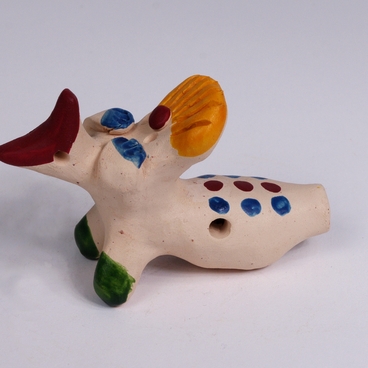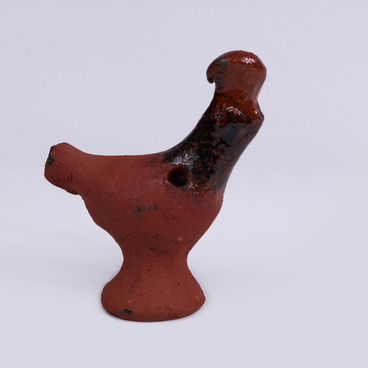This bird was created by Valentin Shevelyov, a hereditary craftsman from Kargopol. Even though the master already had the name for the item in mind, according to the 20th-century catalogs of the State Museum and Exhibition Center ROSIZO it was exhibited under the name ‘Bird of Happiness’. The artisan modeled a fabulous Kargopol raven. There is a transverse crest with notches on the figurine’s head. The raven proudly rests its wings on its sides.
Klavdiya Shevelyova, the craftsman’s mother, was the first to start modeling the raven type of toy. She created it at the turn of the 1970s. Afterward, this theme was adopted by Valentin and Anna Shevelyov. They also added a new image — a raven wearing a skirt. Since the 1990s, the toymaking has been carried on by Elizaveta and Vladimir Shevelyov.
The Shevelyov family comes from the village of Tokarevo, which was only a few miles from Kargopol along the Pudozh tract. This area is known as ‘the Kargopol land’. Here red clay was mined, which is well suited for both hand modeling and the pottery wheel. The village of Tokarevo no longer exists, but the Shevelyov family has been creating products from local clay up to the present day — by no less than five generations already. The family has revived a dying craft, which in the early 1960s was represented with only craftswoman Ulyana Babkina. There is even a museum in Kargopol dedicated to the Shevelyov family and the Kargopol toy.
Pottery came to the Kargopol area in the 11th — 13th centuries: there, archaeologists found fragments of dishes and other household items. However, it reached its peak only in the 19th century. At first, pottery was only an additional source of income for the peasants. Craftsmen worked at the wheel in winter, when there was no need to work in the fields. During the winter season, a skilled potter could make from 400 to 800 pots and earn up to 15 rubles for them — a considerable amount of money in the 19th century. For example, in 1830, one could buy almost 40 kilograms of beef with it.
The masters did not value the whistles as they cost very little. They were usually given to children as a gift. Some merchants painted toys with natural dyes and used them as a kind of advertisement: a child, seeing a bright figurine on the counter, would pull his parents to it begging ‘Buy, buy me a whistle! ’ At the same time, adults could buy a pot, a kneading-trough, or a jar that they needed in their household.
Researchers do not know what medieval Kargopol toys looked like. Archaeologists managed to find only one horse figurine, created around the 15th — 16th centuries. Judging by it, one can only say that back in those days the ‘bobki’ — the way the toys are called there — were distinguished by their simplified and not necessarily accurate form and detailing.
‘Classic’ toys were first mentioned in the 1870s. They were made from a single piece of clay and usually did not have any additional small parts. The modeling was done only by hand, without special tools: clay was smoothed with fingers and small stones were removed from it so that the product would not crack during firing. Until the late 19th century, the figurines were rarely painted — they were only decorated using the scalded method. Kargopol toys belong to the peasant type of folk toys.
Klavdiya Shevelyova, the craftsman’s mother, was the first to start modeling the raven type of toy. She created it at the turn of the 1970s. Afterward, this theme was adopted by Valentin and Anna Shevelyov. They also added a new image — a raven wearing a skirt. Since the 1990s, the toymaking has been carried on by Elizaveta and Vladimir Shevelyov.
The Shevelyov family comes from the village of Tokarevo, which was only a few miles from Kargopol along the Pudozh tract. This area is known as ‘the Kargopol land’. Here red clay was mined, which is well suited for both hand modeling and the pottery wheel. The village of Tokarevo no longer exists, but the Shevelyov family has been creating products from local clay up to the present day — by no less than five generations already. The family has revived a dying craft, which in the early 1960s was represented with only craftswoman Ulyana Babkina. There is even a museum in Kargopol dedicated to the Shevelyov family and the Kargopol toy.
Pottery came to the Kargopol area in the 11th — 13th centuries: there, archaeologists found fragments of dishes and other household items. However, it reached its peak only in the 19th century. At first, pottery was only an additional source of income for the peasants. Craftsmen worked at the wheel in winter, when there was no need to work in the fields. During the winter season, a skilled potter could make from 400 to 800 pots and earn up to 15 rubles for them — a considerable amount of money in the 19th century. For example, in 1830, one could buy almost 40 kilograms of beef with it.
The masters did not value the whistles as they cost very little. They were usually given to children as a gift. Some merchants painted toys with natural dyes and used them as a kind of advertisement: a child, seeing a bright figurine on the counter, would pull his parents to it begging ‘Buy, buy me a whistle! ’ At the same time, adults could buy a pot, a kneading-trough, or a jar that they needed in their household.
Researchers do not know what medieval Kargopol toys looked like. Archaeologists managed to find only one horse figurine, created around the 15th — 16th centuries. Judging by it, one can only say that back in those days the ‘bobki’ — the way the toys are called there — were distinguished by their simplified and not necessarily accurate form and detailing.
‘Classic’ toys were first mentioned in the 1870s. They were made from a single piece of clay and usually did not have any additional small parts. The modeling was done only by hand, without special tools: clay was smoothed with fingers and small stones were removed from it so that the product would not crack during firing. Until the late 19th century, the figurines were rarely painted — they were only decorated using the scalded method. Kargopol toys belong to the peasant type of folk toys.

